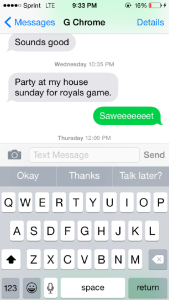With the NFL playoffs just a few weeks away, many sports fans are already planning their post-season parties.


But what’s the best way to plan such a festive event? The Scoop talked with two party planners — Ted Amberg, owner of Amberg Events since the late ’90s, and Bryce Clark, who’s with Spark Event Entertainment — to collect some ideas for setting your bash above the rest.
1. Pick a setting
The first step is picking a time, date, and location, Amberg says. Game time is out of your control, so that’s one less thing to worry about. Furthermore, for someone is hosting a party to watch the Super Bowl, or opening day of the regular season, then the date is decided for you.
But if you want to host a party to watch the Major League Baseball, National Basketball Association, or National Hockey League playoffs, there is more freedom, as all three leagues play multiple games for every playoff round. In this case, you can pick which game to watch.

Which game you decide is party-worthy depends on several factors. If you want the party to continue long after the game is over, then a Friday or Saturday night game is ideal. If you want to maximize turnout, then check the calendar to see what days are already event-free.
“It’s important for any party to look at what else is happening,” Amberg recommends. “…So understand the time of year, what’s going on in the community, if there is any major events going on anything like that, it’s important to look at.”
If you’re planning a month in advance, it’s a bad idea to plan for the day Game 7 of the World Series because there is no guarantee your team will reach the World Series, or that the series will even go to Game 7.
If you are planning with a group of friends, someone will need to volunteer to host.
2. Have an objective
Once you have picked the perfect setting, it’s time to determine what kind of party you want to have. “You want to establish what your objective is,” Amberg says. “A lot of people just go, ‘Well, I want to have a party.’ But what’s your objective? Are you wanting to entertain all ages? Do you want to entertain certain criteria or demographic of people?”
“Party” can be as small as a get-together of close-knit friends or as large as a kegger. A post-season party can mean watching a game together, or just hanging out on a weeknight. What kind of party you have will influence who you invite.
Also, you must decide whether alcohol will be available. “That just depends on the person,” Clark says. “A lot of people want alcoholic beverages; some people prefer not to [drink]…I think it’s a great way to make a fun environment for your party, if they’re open to doing so.”
Says Amberg: “I think it’s fine. You just want to do like what Budweiser says: ‘Drink responsibly.’ If there are kids, or families present, you know keep control, rein it in. I don’t think there’s a problem with having alcohol. For things like casino night and adult events, I think alcohol actually helps —loosens people up. People enjoy themselves more. Not as uptight of a party.”
3. Get the needed provisions
Contact the people involved in planning, and then figure out who is going to provide food and what you will do for entertainment, Amberg says. Preparations should be made before the invitations can be sent.

If you are planning this event with friends, everyone needs to take some responsibility and bear some of the financial cost. Group or no group, the amount food, drinks, and other items that you can afford will determine the size of your guest list.
When buying things for the party, keep the theme in mind. As Amberg points out, “If you want to be a creative party planner, and you’re looking for a home party, yeah, it always adds to the experience and the ambiance if you have, say, trays that look like footballs. It adds to that fun.”
4. Send the invitations

The first three steps will determine how many of your friends you can invite and who would be good to invite. The most important limit is your location.
Clark has a basic rule to follow: “One person for every five square feet.” Furniture can affect that calculation; it’s better to invite fewer people and have unused space than to try to cram your home or apartment full of people.
5. Set up for the party
Amberg knows that the days right before an event are the most stressful.
“As we lead up to that actual event day, we start looking at things like weather, making secondary options if the weather looks bad, verifying attendance numbers. Then a lot of the time, we’ll set the event the day before.”
Depending on how elaborate the decorations are and how big the location is, the day before the event or the day of will work fine for decorating.
If you were planning on watching the game outside — say you were planning on tailgating and watching the game on your laptop or phone — then weather is a concern. But if you’re indoors, then it doesn’t really apply to you.

It’s also important that your location is as clean as can be. If it’s in your apartment or house, having a dirty watching room will affect not only how your friends see you, but also their overall viewing experience.

If there are two games going on at the same time as your party, Clark advises putting extra preparations in place. “Hopefully, provide two different ways to watch the game,” he says. “So setting the games up on two different TVs, or making the TV split-screen.”
6. Be a lively host
The party itself should run smoothly, as the entertainment is already in place. In fact, it’s the reason for having the party in the first place.
While hosting, it’s important to keep the guest in mind at all times. “I think that’s actually a good thing to say about any event,” Amberg says. “As a host, as a party planner, you don’t really care about what is happening at the party or what attractions you have. That doesn’t matter. That’s secondary criteria. The first criteria is making sure people leave having had a positive experience. A saying I like to use: ‘No one remembers what you said or what you did; they remember how you made people feel.’ So if you make them feel in a positive way, then that’s what they’re going to take back with them.”